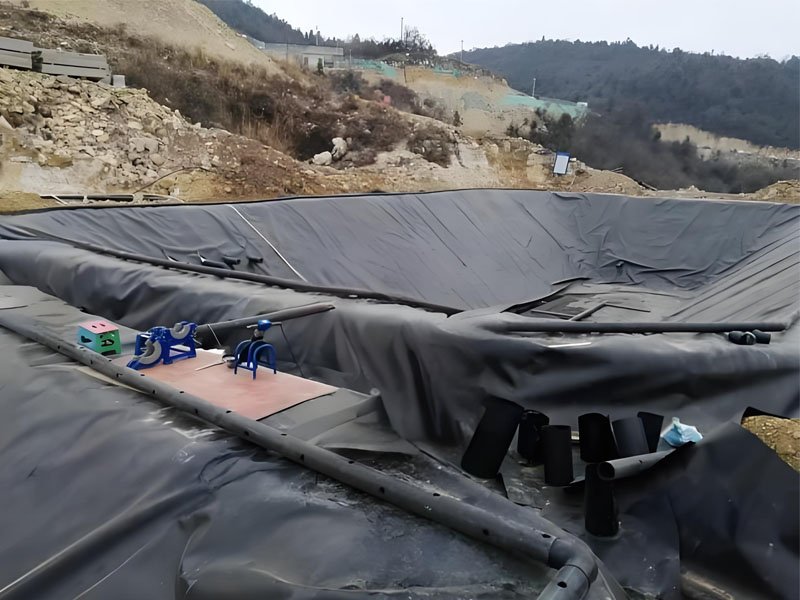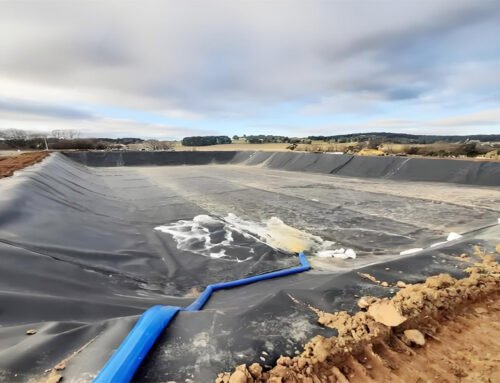There are various places where we can easily observe that water is infrequent, and there are different things we need to make sure to keep the water hygienically. Numerous people have used alternate procedures to keep the water, like RCC water storage tanks, etc., but these alternatives are very costly and time-consuming. At the same time, customers can use our HDPE sheet for pond liner to keep water hygienically for an extended time. GEOSINCERE Geosynthetics HDPE sheet for pond liner is cost-effective and can be form fitted very securely and quickly without any practical possibilities. According to us, an outstanding HDPE sheet for pond liner retains water in ponds for a lengthier period and helps maintain dregs, residue, waste, and detritus.
1. What Is An HDPE Sheet for Pond Liner?
HDPE sheet For Pond is a type of pond liner synthetic from high-density polyethylene. It is resilient to holes, tears, and snags, the faultless choice for up to 30 feet in diameter ponds. These are also very light in weight and easy to transport, so you can shift them around as required.


2. Applications of HDPE Sheet Pond Liners:
HDPE sheet pond liners find various applications across different industries and settings
- Decorative Landscaping: HDPE sheet pond liners are commonly used to create attractive water features, ponds, and fountains in gardens, parks, and residential landscapes.
- Aquaculture: Fish farmers and enthusiasts use HDPE sheet pond liners to construct fish ponds, hatcheries, and shrimp farming enclosures, providing a controlled aquatic environment for optimal growth and health.
- Storm water Management: HDPE sheet pond liners are employed in storm water management systems, where retention and detention ponds use the to prevent water infiltration and effectively manage runoff during heavy rains.
- Wastewater Treatment: In industrial and municipal wastewater treatment facilities, are utilized to create containment ponds, ensuring proper treatment and storage of wastewater without contamination.
- Mining and Industrial Applications: HDPE sheet pond liners are employed in tailings ponds, leach pads, and other mining and industrial applications to contain and manage potentially harmful materials.
- Water Reservoirs: HDPE sheet pond liners line large reservoirs and storage tanks, preventing water loss through seepage and evaporation.
3. How To Choose Right HDPE Sheet For Pond?
Choosing the right HDPE (High-Density Polyethylene) sheet for a pond is crucial for ensuring durability, leak prevention, and long-term performance. Here are the key factors to consider when selecting an HDPE sheet for your pond:
3.1 Thickness of the HDPE Sheet
Thicker sheets are more durable and resistant to punctures, tears, and UV damage.
For small ponds, a thickness of 0.5 mm to 1 mm is usually sufficient.
For larger ponds or those with heavy usage (e.g., fish ponds), opt for 1.5 mm to 2 mm or thicker.
Consider the substrate: If the pond base has sharp rocks or roots, choose a thicker sheet for added protection.
3.2 UV Resistance
Ensure the HDPE sheet is UV-stabilized to withstand prolonged exposure to sunlight without degrading.
UV-resistant sheets will last longer and maintain their integrity in outdoor conditions.
3.3 Material Quality
Choose virgin HDPE instead of recycled material for better strength, flexibility, and chemical resistance.
Virgin HDPE is less likely to have weak spots or inconsistencies.
3.4 Pond Size and Shape
Measure the pond’s dimensions (length, width, and depth) to determine the size of the HDPE sheet required.
Ensure the sheet is large enough to cover the entire pond with extra material for overlapping and anchoring (typically 1-2 feet extra on all sides).
3.5 Chemical Resistance
HDPE is naturally resistant to most chemicals, but confirm that the sheet can withstand specific conditions in your pond, such as fertilizers, fish waste, or water treatments.
3.6 Flexibility and Durability
HDPE sheets should be flexible enough to conform to the pond’s shape without cracking or tearing.
Check the sheet’s tensile strength and puncture resistance to ensure it can handle the pond’s environment.
3.7 Environmental Factors
Consider the climate: In colder regions, ensure the HDPE sheet can withstand freezing temperatures without becoming brittle.
For areas with high wildlife activity, choose a thicker sheet to resist damage from animals.
3.8 Installation Requirements
Ensure the sheet is easy to install and can be welded or sealed effectively to prevent leaks.
Look for sheets with smooth surfaces for easier installation and better water flow.
3.9 Certifications and Standards
Choose HDPE sheets that meet industry standards for pond liners, such as NSF/ANSI 61 certification for potable water or GMP (Good Manufacturing Practice) standards.
3.10 Cost vs Quality
While cost is a factor, prioritize quality to avoid frequent repairs or replacements.
High-quality HDPE sheet pond liner may have a higher upfront cost but will save money in the long run.
3.11 Supplier Reputation
Purchase from a reputable supplier or manufacturer with positive reviews and a history of providing reliable pond liners.
Ask for recommendations or consult with professionals if unsure.


4. How to Install HDPE Sheet For Pond?
4.1 Preparation
For aquaculture ponds, start by selecting a high-quality GEOSINCERE HDPE sheet with suitable thickness and dimensions. Gather necessary tools like adhesive or welding equipment specifically recommended by GEOSINCERE, along with auxiliary materials such as sandbags. Inspect the pond site, removing topsoil, impurities, and ensuring proper compaction and slope treatment.
4.2 Installation
Carefully unroll the GEOSINCERE HDPE sheet on the prepared foundation. Adjust its position to cover the entire pond bottom and sides. For seam processing, follow GEOSINCERE’s guidelines: clean the seam area and use hot wedge or extrusion welding, or apply the recommended adhesive evenly. Ensure a tight bond by pressing the sheets together.
4.3 Fixation and Sealing
Around the pond perimeter, dig anchor trenches according to design specifications. Embed the edges of the HDPE sheet into these trenches, ensuring they extend adequately at the bottom and are snug against the trench walls. Backfill the trenches with soil or fine sand in layers, compacting each layer to secure the sheet firmly and prevent movement. This step is crucial for the long-term stability and sealing of the pond, preventing water leakage and ensuring durability.
5. Summary
The right HDPE sheet for your pond depends on factors like thickness, UV resistance, material quality, and environmental conditions. For most applications, a UV-stabilized, virgin HDPE sheet with a thickness of 1 mm to 2 mm is a good choice. Always ensure proper installation and anchoring to maximize the liner’s lifespan and effectiveness.
If in doubt, consult with a pond construction expert or supplier to select the best HDPE sheet for your specific needs.
GEOSINCERE brand Black High Density Polyethylene Pond Liner and other geosynthetics products and solutions can meet your requirements by our solid technologies, innovative engineering solutions and excellent customer services. GEOSINCERE always tries our best to solve the most complex civil, mining and environmental challenges with our innovative and high performance geosynthetic products. Quality assurance, factory price and fast delivery time are our competitive advantages.
We have been exporting HDPE liners and geosynthetics to over 100 countries. They choose Geosincere as partner for more than 10 years.





